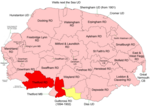Mundford

Mundford is a village and civil parish in the English county of Norfolk. It is situated at the intersection of two major routes, the A134 Colchester to King's Lynn road and the A1065 Mildenhall to Fakenham road, about 8 miles (13 km) north west of Thetford. The village is 35 miles (56 km) from the city of Norwich and 88 miles (142 km) from London.The villages name means 'Munda's ford'. The civil parish, in 1845, had 437 inhabitants, and 1609 acres of land, exclusive of a common of 190 acres, and also 90 acres of heath, where the parishioners had the right of fuel and rabbits, but no pasturage. Today it has an area of 2,060 acres (830 ha) and in the 2001 census had a population of 1,591 in 669 households. The population at the 2011 Census had reduced to 1,526 in 652 households. The parish shares boundaries with the adjacent parishes of Didlington, Cranwich, Weeting-with-Broomhill, Lynford and Ickburgh. The parish falls within the district of Breckland. Local government responsibilities are shared between the parish, district and county councils.
Excerpt from the Wikipedia article Mundford (License: CC BY-SA 3.0, Authors, Images).Mundford
Swaffham Road, Breckland District
Geographical coordinates (GPS) Address Nearby Places Show on map
Geographical coordinates (GPS)
| Latitude | Longitude |
|---|---|
| N 52.508281 ° | E 0.655746 ° |
Address
Swaffham Road
Swaffham Road
IP26 5EH Breckland District
England, United Kingdom
Open on Google Maps










